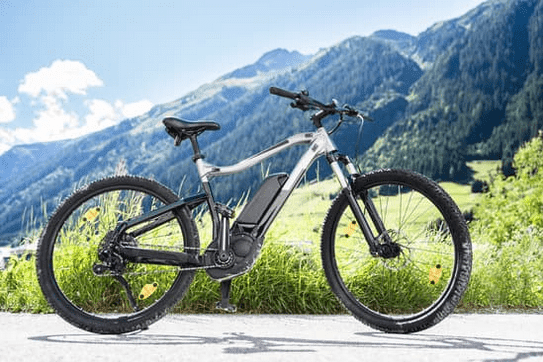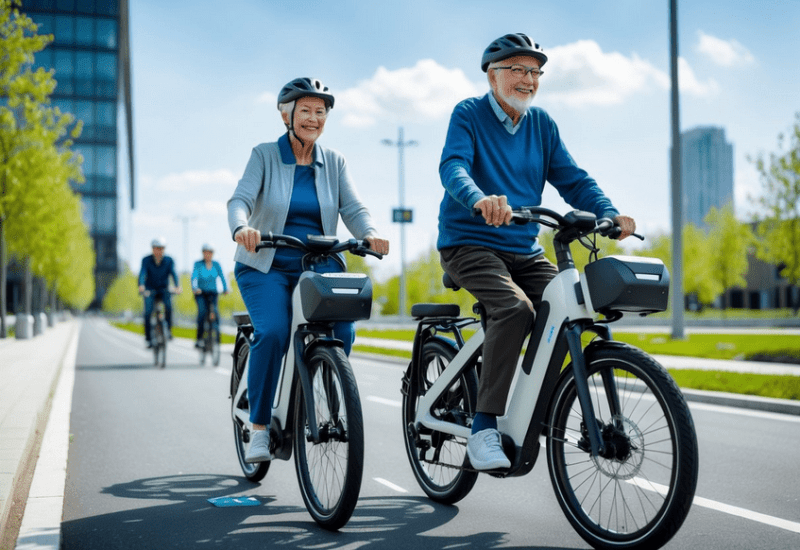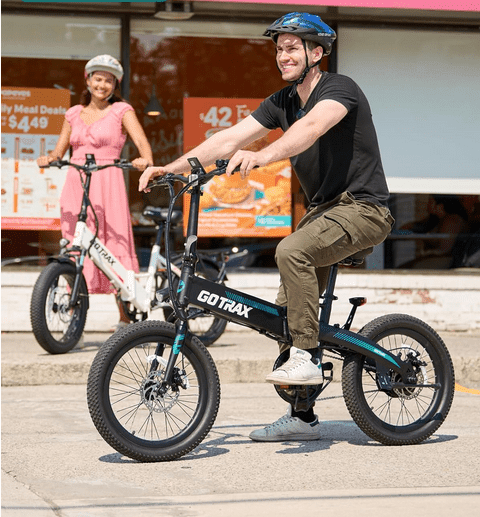Electric Bike Winter Storage: How To Store Your Ebike In The Winter

Electric bike riders face a yearly conundrum when the temperature drops and frost patterns begin to appear on our windows: where to store their faithful companions during the chilly winter months.
With years of expertise in ebike technology and bicycle maintenance, we know how important it is to store your bike properly for the winter so that it will be ready to go when the weather warms and spring arrives.
It takes more than just packing your electric bike away to make sure it survives the cold; it needs careful maintenance, particularly for its battery. Sciencedirect.com research indicates that storing batteries at normal temperature can greatly increase their longevity and efficiency.
Continue reading as we explore tried-and-true techniques that will protect your e-bike from winter's severe effects. Learn tips for a hassle-free hibernation that guarantee a seamless transition to the warmer days to come!
Key Takeaways
- Clean your electric bike and keep its battery charged to 75% - 80% before storing it in a cool, dry place for winter.
- Use a bike cover to protect your e-bike from dust and moisture while it's stored away.
- Store the battery and LCD screen inside to prevent damage from cold temperatures.
- Before riding in winter, check your e-bike's tires, have a tune - up at a local shop, use fenders to block mud, and wear helmets with warm layers.
- When you use your electric bike during winter, only ride when it’s safe outside. Practice slow braking on slippery roads and make sure you can be seen with lights.
Storing Your Electric Bike for the Winter

Make sure your electric bike survives the winter by giving it a thorough cleaning, putting it in a cool, dry place, and being especially cautious when it comes to battery storage. By doing routine maintenance now, you can avoid future problems in the spring.
Cleaning the e-bike before storing it is essential.
It's important to clean your electric bike before storing it for the winter. Your bike's components may rust and sustain damage from dirt and dampness. Using a cloth, clean the handlebars, seat, wheels, and frame.
Make sure the Bike is Completely Dry to Prevent Water Damage.
Don't forget to clean the battery contacts. They may corrode or stop working properly later on if they are unclean or damp. After disconnecting the battery, clean the metal components where they attach to your e-bike with a dry towel.
To keep your clean e-bike in good condition while you're not riding it, store it somewhere cool and dry.
Keeping Stored in a dry, Cool Place away from Intense Humidity
Store your e-bike somewhere that isn't too hot or too cold. This helps protect it from moisture-related harm. Garages and basements are good spaces if they don't get too hot or too chilly.
To ensure that the area remains dry over time, always check it first.
For added safety, put a bike cover on your e-bike. It prevents dirt and dust from collecting on your bike when it's not in use. Additionally, if moisture manages to seep into the space where you store your bike, the cover prevents the parts from rusting.
Just make sure the cover fits properly and completely encloses your bike to keep everything dry and clean.

Putting on a Bike Cover for Extra Security
Consider purchasing a bike cover once you've located the ideal spot for your electric bike somewhere dry and cool. Your e-bike will be protected from winter weather by a quality cover. It keeps moisture, dirt, and debris away that could lead to rust or other problems.
Make sure the cover fits properly to prevent water intrusion or wind-blown removal.
To keep your electric bicycle dry and safe, get a windproof cover. Tightly fasten it around your e-bike to avoid any issues caused by severe gusts. This helps ensure that your electric bike is safe to use after being kept throughout the winter and ready for action come springtime.
LCD screens and Batteries Should be Kept Dry and Cool:
It is essential to store the batteries and LCD screens of your electric bike in a dry, cold place when winterizing it. The batteries' lifespan can be increased by keeping them between 75 and 80 percent charged and keeping them out of the cold.
Similarly, keeping the LCD screens out of the freezing weather and ensuring peak performance in the winter requires storing them in a cool, dry place. Following these storage guidelines will help you preserve the best possible condition for your bike's essential parts for the return of warmer weather.
Recall that preserving the best possible battery performance through appropriate storage can have a big impact on how long the battery lasts. In a similar vein, keeping LCD panels protected from extremely low temperatures by storing them in the right circumstances helps ensure that they work well during winter storage.
Keeping Batteries Between 75% and 80% Charged
To extend the life of your electric bike's batteries, store them between 75% and 80% charged over the winter. When you're ready to use your e-bike again, the battery will remain efficient thanks to the ideal charge level that helps maintain its health.
Moreover, maintaining the batteries at this charge level extends their lifespan and keeps them from deteriorating in cold climates.
Recall to store the batteries in a cool, dry location rather than under below-freezing conditions. By taking these easy precautions, you can make sure that the batteries in your electric bike are in good condition and prepared for use when the weather warms up again.
Winter Pre-Ride Checklist

Before heading out for a winter ride on your electric bike, it's essential to ensure that your ebike is in top condition. This includes checking the tires, scheduling a tune-up at a local bike shop, using fenders for protection against dirt and debris, and gearing up with helmets, proper layering, and protective gear.

Taking The E-bike for a Tune-up at a Local Bike Shop
It's essential to take your electric bike to a nearby bike shop for a tune-up when it's time to prepare it for winter riding. A professional tune-up guarantees smooth gear changing, well-lubricated chains, calibrated brake and gear lines, and brake pads in good condition.
When bringing out your e-bike after winter, this maintenance check will also assist uncover any potential difficulties that might have developed during storage, providing a safe and comfortable riding experience.
Recall that having your e-bike professionally inspected at a bike shop after keeping it for a long time during the winter can help to ensure that it operates at its best.
Checking the Condition of the Tires:
It's important to check for wear and tear on the tires of your electric bike before riding in the winter. To guarantee appropriate traction on slick roads, check the tire inflation. In addition, check the tread depth for good traction on snow and ice, paying close attention to any damage or punctures.
For better traction, think about utilizing winter-specific tires with deeper treads and a softer rubber compound. Maintain and clean your tires regularly to keep them from rusting, especially during the salty winter months.
A safe winter ride requires well-maintained tires because of things like slippery roads and low visibility. To have the best possible traction control—which is essential for maneuvering through slick conditions—you should regularly inspect your tires.

Using Fenders for Protection Against Dirt and Debris:
It's important to check the tires' condition and use fenders to protect against dirt and debris. During winter riding, mudguards or splash guards protect your electric bike from dirt, water, and debris.
These are necessary winter cycling gear that keeps your bike clean and shields important parts from dirt and debris damage. Not only do waterproof fenders keep you dry, but they also guarantee that your e-bike will continue to function as best it can even in inclement weather.
By serving as a splash barrier, these fenders effectively protect your electric bike and you from the elements.
While maintaining the condition of your tires is crucial when riding in the winter, installing sturdy fenders on your e-bike to protect you from any debris when you ride in inclement weather is also essential.

Using Helmets, Proper Layering, and Protective Gear:
It's important to keep them comfortable and safe when winter biking. The first step in keeping warm without perspiring excessively is to wear helmets for head protection and insulating clothing.
This guarantees that you're well-prepared for the cold weather riding circumstances, together with thermal gear and padded knee guards. Your defense against potential threats is further strengthened by wearing safety equipment, such as arm protection, which not only makes winter cycling safer but also warmer.
This safety equipment is enhanced by headlights, which make sure that you can be seen by others when riding in poor visibility or inclement weather. These safety measures are crucial parts of an all-encompassing strategy for winter cycling.
Using Your E-bike During the Winter
When using your bike during the winter, it's important to only use it in safe weather conditions, practice safe braking in slippery conditions, and improve visibility with headlights.
To learn more about how to safely use your electric bike during the winter months, keep reading for helpful tips and strategies.
Only Using the E-bike in Safe Weather Conditions:
When riding an e-bike during winter, it's crucial to use it only in safe weather conditions. This means avoiding heavy snow, icy roads, and other hazardous weather situations. By doing so, you can ensure a safer and more enjoyable riding experience.
Improving visibility with headlights is also essential when using your e-bike during the winter months. This increases your visibility to others on the road and reduces the risk of accidents.
Additionally, practicing safe braking in slippery conditions will help prevent skidding or losing control of your bike.
Practicing Safe Braking in Slippery Conditions
It's crucial to practice safe braking in slick situations when riding in the winter. Make sure you give yourself enough time to reduce your speed gradually and keep a safe distance from other cars and obstructions.
A vital component of winter riding safety is preventing skidding on icy or snowy roads. To do this, maintain a moderate pace and refrain from using quick or forceful brakes. You can increase your e-bike's safety in inclement weather and control on slick terrain by using these tactics.
Recall that maneuvering over ice road hazards requires the use of safe braking techniques in slick circumstances. In the winter, use these braking tactics to guarantee a more controlled and safe ride, especially in inclement weather like snow or ice.
Improving Visibility With Headlights:
Having headlights for your electric bike throughout the winter is essential for increased safety and visibility. You may improve your visibility with headlamps and daytime running lights, especially in low-light situations like snow or fog.
This is necessary so that you can see potential hazards on the road and so that other people can see you. Furthermore, luminous clothing is essential for increasing your visibility to other drivers.
The weather-resistant design of Aventon e-bikes further guarantees use throughout the winter, although it's always a good idea to give proper illumination and reflective materials priority.
Riding throughout the winter also requires you to practice safe braking in slick circumstances. In addition to increasing visibility, headlights make it easier to brake safely by enhancing your ability to see the road ahead.
Conclusion:
In conclusion, preparing your electric bike for winter storage is crucial. Proper cleaning and secure storage help prevent damage and ensure optimal performance when you bring it out again.
Regular maintenance, including tuning up components and checking battery levels, will keep your e-bike in top condition when the cold weather subsides. Following these tips will help protect your investment and ensure that you are ready to hit the road as soon as spring arrives.
Recent Featured Articles:
Exploring Maryland's Top E-Bike Trails: Our Picks!
Utah's Top E-Bike Trails: A Thrilling Adventure
5 Common E-Bike Maintenance Mistakes to Avoid



